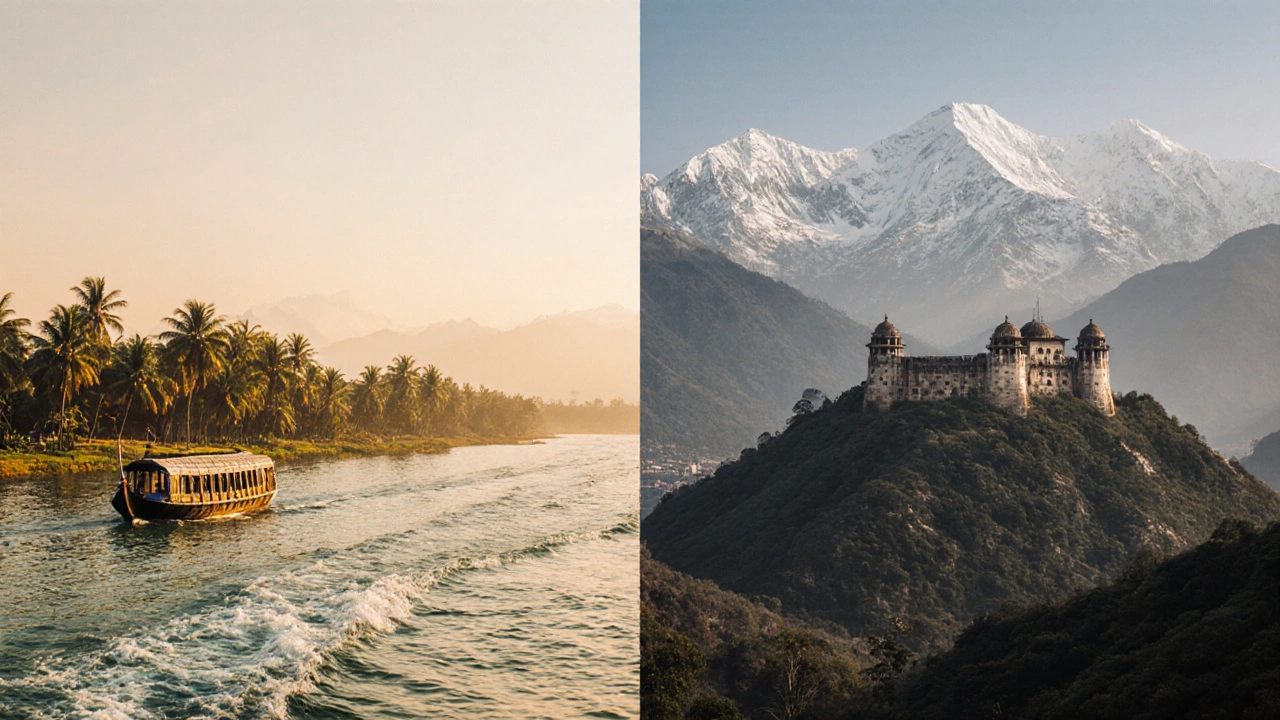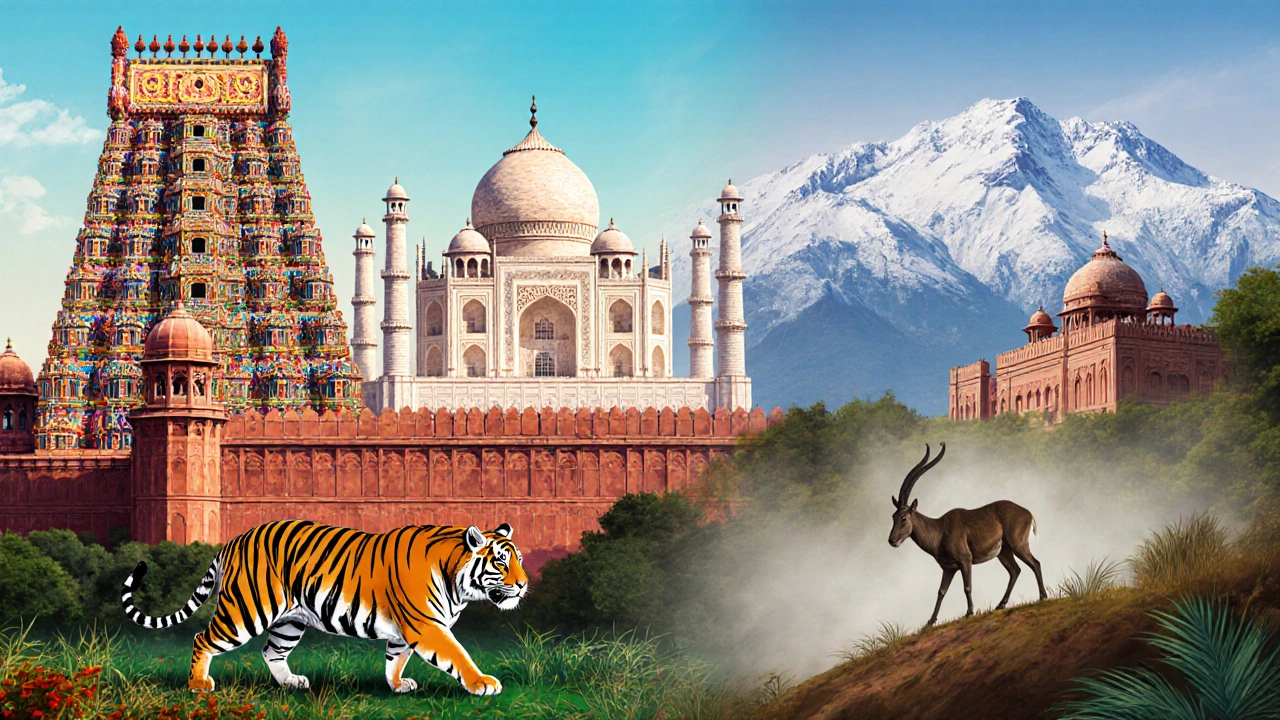Southern India vs Northern India: Which Travel Experience Wins?
 Oct, 17 2025
Oct, 17 2025
Ever wondered whether a holiday in southern India or northern India will give you the memories you crave? Both parts of the subcontinent boast jaw‑dropping scenery, distinct cuisines, and cultural quirks you won’t find anywhere else. This guide breaks down the most common travel criteria so you can decide which side of the country suits your vibe.
Setting the stage: What we’re comparing
We’ll look at five practical dimensions that most travelers care about:
- Climate and best season to visit
- Food and drink profiles
- Heritage and cultural highlights
- Nature and wildlife experiences
- Cost and accessibility
Geography at a glance
Southern India is the region that stretches from the Arabian Sea in the west to the Bay of Bengal in the east, covering the states of Kerala, Tamil Nadu, Karnataka, Andhra Pradesh and Telangana. Its terrain blends rolling Western Ghats, sun‑kissed beaches, and lush backwaters. Northern India encompasses the Himalayan foothills, the fertile Indo‑Gangetic plain, and the arid deserts of Rajasthan, spanning states like Himachal Pradesh, Uttarakhand, Uttar Pradesh, and Delhi. The north is famous for snow‑capped peaks, sprawling plains, and bustling historic capitals.
Climate and the perfect travel window
Southern India enjoys a tropical climate. The coastal belt (think Kerala) stays warm year‑round, with monsoon rains from June to September. The best dry window is November to February, when temperatures sit between 25‑30°C, ideal for beach hopping and backwater cruises.
Northern India sees a wider range. The plains (e.g., Uttar Pradesh) are scorching from April to June (up to 45°C) and cool from November to February (5‑20°C). The Himalayas offer a short summer window (May‑September) for trekking, while the desert of Rajasthan is pleasant from October to March.
Food: Spice, sweet, and everything in between
Southern kitchens rely heavily on coconut, rice, and tamarind. Dishes like appam, idiyappam, and the fiery chettinad chicken dominate. Seafood is abundant along the coast, and the iconic filter coffee powers mornings. If you love a quick, sour, and slightly sweet palate, the south will feel like home.
North Indian plates are richer in dairy and wheat. Think buttery dal makhani, flaky naan, and meat‑laden gravies like roug mash. Street snacks such as pani puri and the festive sweets of gajar ka halwa are must‑tries. The north also offers unique regional flavors, from the mustard‑infused dishes of Bengal (though technically eastern) to the robust kebabs of Rajasthan.
Heritage sites and cultural immersion
The south showcases Dravidian temple architecture with towering gopurams. Mysore Palace in Karnataka dazzles with its Indo‑Islamic blend, while Tamil Nadu’s Meenakshi Amman Temple offers a kaleidoscope of sculptures. The backwaters of Kerala provide a serene backdrop for houseboat stays, letting you drift past traditional villages.
In the north, the Mughal marvel of the Taj Mahal steals the spotlight, but the region is also home to the grand forts of Jaipur-Amber Fort and City Palace-along with the ancient Buddhist sites of Sarnath. The Himalayan towns of Leh and Manali add a spiritual dimension with monasteries and festivals.

Nature, wildlife and adventure
South India’s Western Ghats are a biodiversity hotspot. You can trek through the misty slopes of Coorg, spot the elusive Nilgiri tahr, or snorkel around the coral reefs of Andaman (though technically an union territory). The Bandipur and Periyar wildlife reserves offer tiger safaris and elephant encounters.
Northern India gives you the Himalayas for high‑altitude trekking-think the Stok Kangri or the classic Manaslu Circuit. The desert landscapes of Rajasthan provide camel safes and the chance to watch sunrise over sand dunes in Jaisalmer. For birdwatchers, the wetlands of Keoladeo National Park in Uttar Pradesh are a seasonal haven.
Cost of travel and ease of getting there
Both regions have budget‑friendly options, but the south tends to be slightly cheaper for accommodation and food, especially in Kerala’s homestays and Tamil Nadu’s guesthouses. Domestic flights are plentiful; the major airports in Chennai, Bengaluru, and Hyderabad connect to most Indian metros.
The north’s main gateways-Delhi, Jaipur, and Amritsar-also receive frequent flights. However, the peak tourist season (October‑March) can drive up prices in hill stations and desert camps. Train travel is a picturesque way to cross the north, especially the UNESCO‑listed Kalka-Shimla line.
Side‑by‑side comparison table
| Factor | Southern India | Northern India |
|---|---|---|
| Best months | Nov‑Feb (dry), Dec‑Jan (cool) | Oct‑Mar (pleasant), May‑Sept (Himalayan trekking) |
| Typical climate | Tropical, humid, monsoon | Temperate to alpine, arid deserts |
| Signature cuisine | Coconut‑based, rice, seafood | Wheat‑based, dairy, rich gravies |
| Top heritage sites | Meenakshi Temple, Mysore Palace, Hampi | Taj Mahal, Amber Fort, Golden Temple |
| Nature highlights | Western Ghats, backwaters, beaches | Himalayan peaks, Thar Desert, wetlands |
| Average daily budget (USD) | $30‑$60 (hostels to mid‑range) | $35‑$70 (hostels to mid‑range) |
Who should choose the south?
If you love warm weather, sea breezes, and a relaxed pace, the southern stretch is perfect. It’s ideal for families who want safe beach resorts, couples seeking romantic houseboat nights, or solo travelers chasing waterfalls and spice markets.

Who should head north?
Adventure junkies, history buffs, and culture seekers often gravitate to the north. The Himalayas deliver adrenaline, while the forts and palaces satisfy a craving for regal drama. Winter festivals in Delhi or the kite‑flying extravaganza in Jaipur add a festive flavor.
Quick checklist before you book
- Decide on the climate you enjoy - tropical heat vs seasonal chill.
- Pick a cuisine focus - coconut and seafood vs rich gravies and breads.
- Map out must‑see heritage sites: temple towns in the south, forts and monuments in the north.
- Plan activities: backwater cruises versus Himalayan treks.
- Set a budget - both regions are affordable, but peak season spikes differ.
Final verdict: South or North?
There’s no absolute “better” answer - it boils down to your personal travel style. If you crave coastline, lush greenery, and a laid‑back vibe, the south will likely win. If you’re after dramatic landscapes, grand palaces, and a mix of cool and scorching temps, the north takes the lead. Either way, India guarantees unforgettable moments.
Frequently Asked Questions
When is the safest time to travel in southern India?
The dry season from November to February offers pleasant temperatures, low humidity, and minimal cyclone risk, making it the safest window for most travelers.
Do I need a visa to explore both regions?
Yes. All foreign visitors need an appropriate Indian visa, whether you stay in the south, the north, or both.
Which region is better for budget travelers?
Both are budget‑friendly, but the south generally offers cheaper homestays and meals, especially in Kerala and Tamil Nadu.
Can I travel between the two regions by train?
Absolutely. Major rail routes connect Chennai and Bengaluru to Delhi, Jaipur, and beyond, though the journey can take 30‑40hours.
What health precautions should I take?
Stay hydrated, carry a basic first‑aid kit, and consider vaccinations for HepatitisA, Typhoid, and optional COVID‑19 boosters. In the south, watch out for mosquito‑borne diseases during monsoon; in the north, protect against altitude sickness if trekking high.